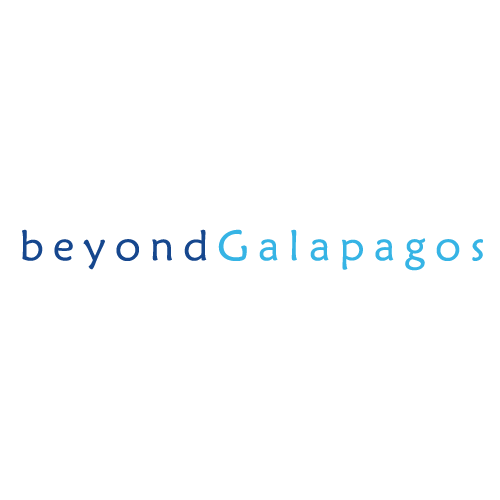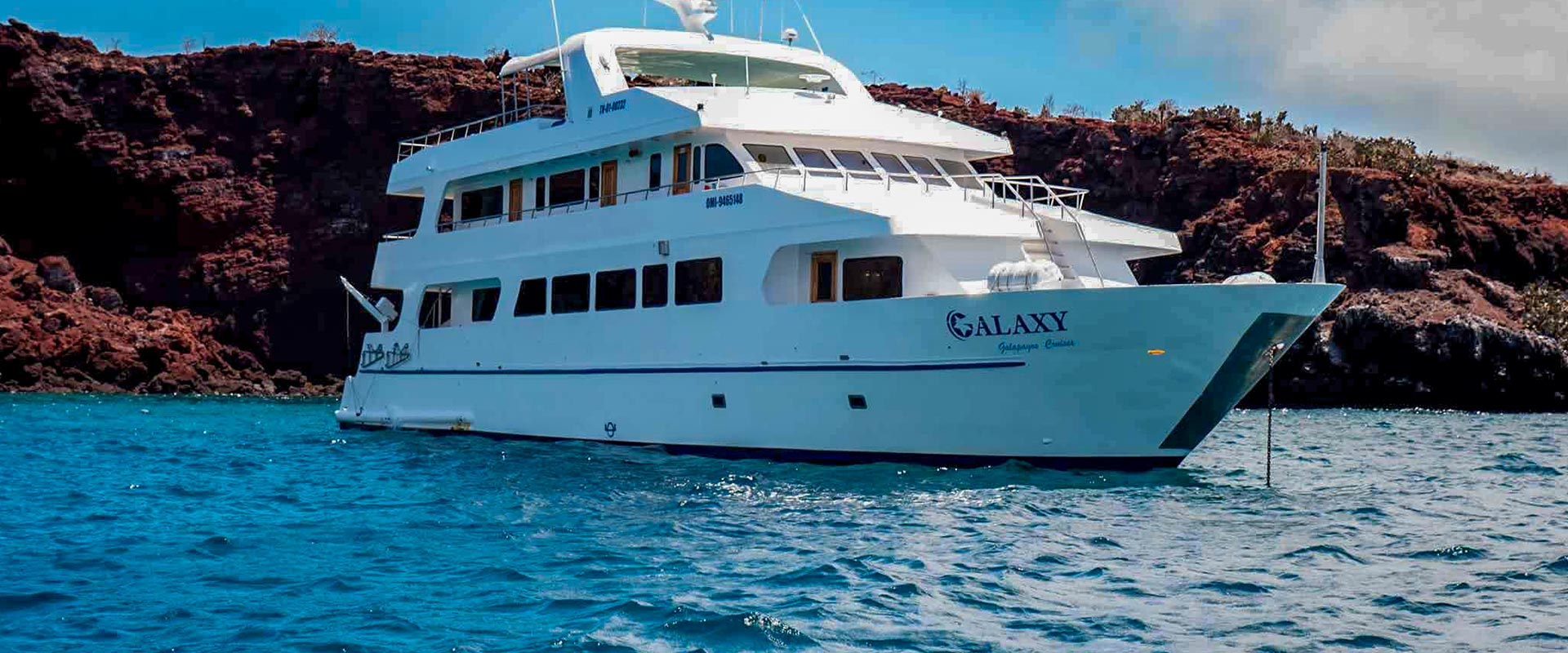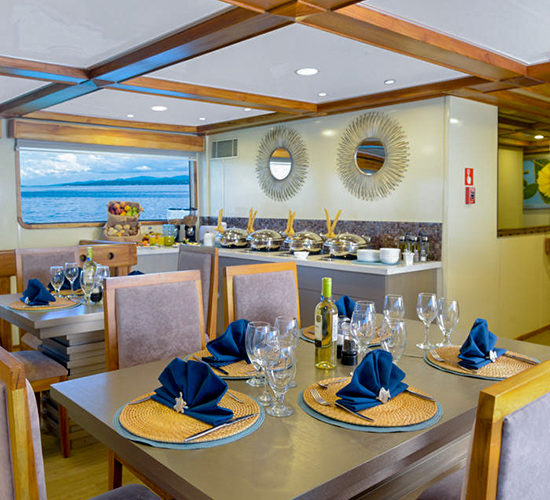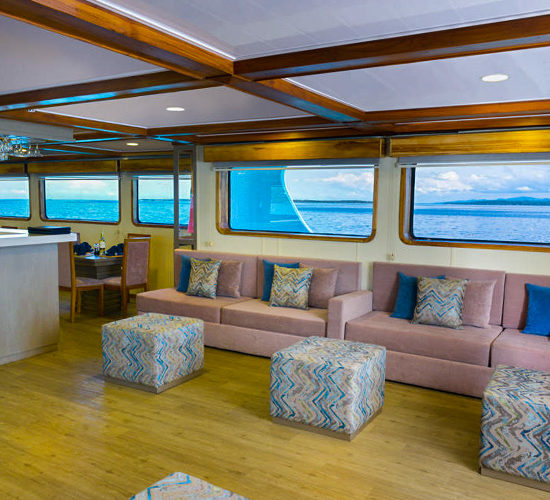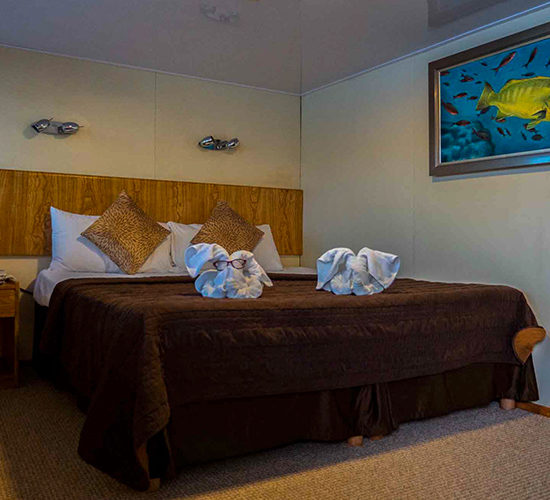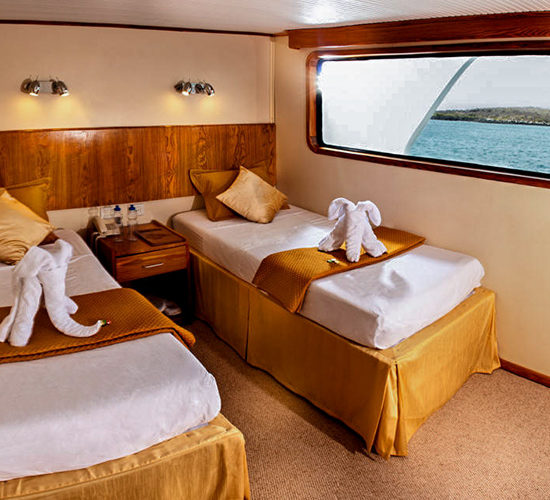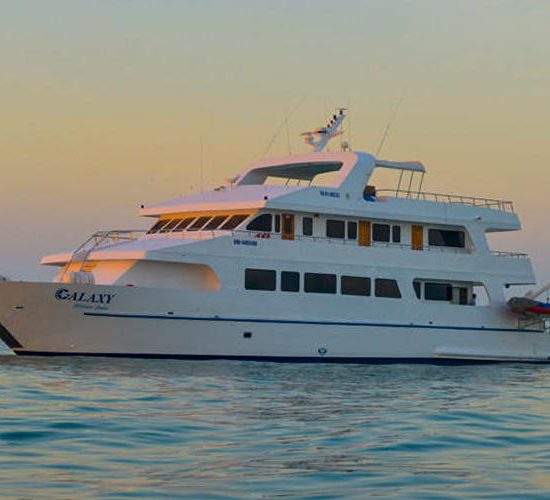Motor Yacht Galaxy
Special Features:
Capacity: 16 guests
Departure day: Tuesday, Thursday, Saturday
Cruise length: 4, 5, 6, 8 days
Available: Kayaks, snorkelling equipment, wetsuits
Ideal for honeymoon or anniversary trips
Ideal for Family or small groups charters
Islands to visit, depending on the itinerary:
San CristobaI Island, Española Island, Floreana Island, Santa Fe Island, Plazas Island, Santa Cruz Island, Isabela Island, Fernandina Island, Santiago Island, Rabida Island, Chinese Hat Islet, North Seymour Island, Mosquera Islet, Santiago Island, Bartolome Island, Genovesa Island.
Galaxy Motor Yacht is a good superior-class cruise that offers comfortable stay whilst visiting this wonderful paradise
This comfortable yacht has been in the Galapagos Islands since 2007, offering good service and wonderful Galapagos expeditions. When you book a superior-class cruise, the ideal yacht is Galaxy yacht due to its ample social areas, good service and complete itineraries.
GALAXY YACHT - BRIEF ITINERARY
Please check complete itineraries on top
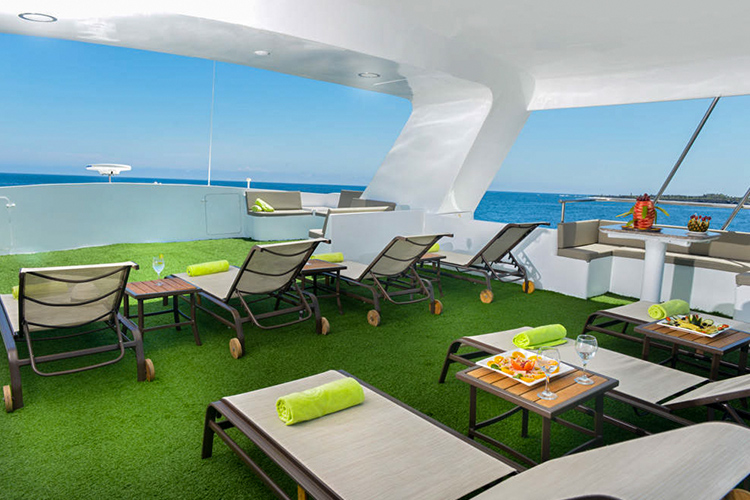
| Thursday | PM: | Santa Cruz: Black Turtle Cove |
| Friday | AM: | Rabida: Rabida |
| PM: | Sombrero Chino: Chineses Hat | |
| Saturday | AM: | Seymour: Seymour |
| PM: | Mosquera: Mosquera | |
| Sunday | AM: | Santiago: Sullivan Bay |
| PM: | Bartolome: Bartolome | |
| Monday | AM: | Genovesa: Barranco |
| PM: | Genovesa: Darwin Bay | |
| Tuesday | AM: | San Cristobal: Interpretation Center |
GALAXY YACHT - RATES
Rates are per person
| Cabin Type | 4 days | 5 days | 8 days |
| Upper & Main deck | $2.157 | $2.890 | $4.982 |
| Lower deck | $2.049 | $2.766 | $4.778 |
| Charter | $24.610 | $35.394 | $55.962 |
| Children under 12 years: 20% discount | |||
| Single supplement: 50% | |||
Included:
Accommodation
All Meals (from lunch on the first day to breakfast on last day)
Drinking water, coffee and tea
Guided visits with a naturalist guide
Use of snorkelling equipment
Use of wetsuits
Use of kayaks
Transfers to and from the airport in Galapagos
Additional:
Galapagos flight ticket
Galapagos entrance fee ($100 per adult & $50 per child, subject to change)
Galapagos migration card ($20 per person)
Soft and alcoholic drinks
Additional tours and transfers
Personal expenses
Meals that are not mentioned
Travel insurance (strongly suggested)
Tips & gratuities
All that is not mentioned
We'd love to help you plan your trip!
Please let us know about your plans
Ready to step into this expedition?
Please fill out the form let us guide you through your next dream holiday!
-
Departure/Return Location
Quito or Guayaquil | San Cristobal Island, Galapagos Islands -
Dress Code
Comfortable: Good walking shoes, cotton & light pants, shorts, t-shirts, windbraker for the nights, cotton pullover, bathing suit, sandals, sunscreen, sunglasses, hat with a birm, binoculars, camera with a lot of memory, personal kit, personal medicine, water bottle, small back pack
Detailed Itinerary
5 DAY CRUISE: A | Tue-Sat
Day 1: Tuesday - San Cristobal Island
- AM: Arrival at San Cristobal airport, and transfer to the boat
- PM: Lobos Island - Here, you can walk through the beach to observe the big sea lion colony that lives in this place. There is option to swim and snorkel among the seals, frigates, marine iguanas, lava lizards, and the small endemic Galapagos snake.
Day 2: Wednesday - Española Island
- AM: Gardner Bay - After a wet landing, you start a short walk to observe a colony of seals playing on the coastline. You have the oportunity to snorkel here and perhaps a seal wants to join you, but you can spot sea turtles, a good diversity of tropical fish and marine iguanas.
- PM: Suarez Point - This afternoon you have an amazing encounter with the famous blue-footed boobies, nazca boobies, albatross and other bird species that live in this area. You walk through a rocky surphase, enjoying every inch of the way. Here you are able to see the birds doing their mating dance, guarding their eggs or feeding their babies.
Day 3: Thursday - Floreana Island
- AM: - Post Office Bay - Wet landing. Activities: short walk, swimming, snorkeling, explanation of the mail system. Description: Mail Bay is located on the north side of Floreana Island. Captain James Colnett installed an empty barrel to be used as a post office for the whaling fleets that stopped at the Galapagos Islands. You can leave postcards to your friends and relatives here and/or pick up mail to deliver. Back at the ship, Delicious snacks and beverages are waiting for you and after this, a well deserved lunch.
- PM - Cormorant Point - Wet landing, snorkeling and short trekking. This point is located at west of Floreana Island and it is famous for its dark green beach (due to the great quantity of olivine crystals).You can see many marine invertebrates, as well as sea lions, sea iguanas, the frigates and pelicans.
- The other visit you do this afternoon is at Devil's Crown - Enjoy a panga (zodiac) ride around a small island, a satellite islet of Floreana Island. Here, you a group of rocks that resemble a Crown due to the constant erosion caused by the sea. It is one of the best places to snorkel (shallow diving) in the Galapagos Islands due to its excellent visibility that allows you to admire a great variety of fish and other marine life.
Day 4: Friday - Santa Fe & South Plaza Islands
- AM - Santa Fe Island - With 24 km2 and 60 m of height above sea level, this central island is a very special place to visit. It has an incredible bay of turquoise water, protected by a natural barrier of rocks. You can see colonies of seals as hawks fly overhead. This island is home to one of the two species of land iguanas found in the Galapagos. Their main food source is the leaves and fruits from the large, thick cactus found here.
- PM - South Plaza Island - These islands are two small islets, created by an uplifting of the land. The land iguanas are smaller here; they nest during the warm season. The hike goes along an extraordinary cliff where sea birds nest. There are approximately 1000 sea lions (Zalophus Wollebaeki) located on the south side of the Plazas.
Day 5: Saturday - Santa Cruz & Baltra Islands
- AM - Charles Darwin Station - Today after breakfast, you need to get ready to leave the boat, your luggage has to be ready to be taken to the airport, you however, have one last visit before leaving this magical paradise. The Charles Darwin Station is located in the main port on Santa Cruz Island;you take a private bus to the entrance of the breeding center where giant tortoises and land iguanas are kept in captivity. This center is the main breeding site on the islands. Animals that were in danger of extinction on the various islands are kept in this centre to help them reproduce and grow the population on their islands.. Thanks to the dedicated work of several institutions, some species are being saved. Here was the home of Lonesome George, the famous last survivor of the giant tortoise species found on Pinta Island.
- After this special visit, you are taken to Baltra airport for your flight back to Quito or Guayaquil.
6 DAY CRUISE: B | Sat-Thu
Day 1: Saturday - Baltra & Santa Cruz Islands
- AM - Arrival to Baltra airport - Today you arrive to the airport and our representative takes you to boar the boat.
- PM - Santa Cruz Island - Your first visit on the Galapagos is to the highlands of Santa Cruz Island, where you enjoy a nice walk to spot the giant tortoises in their natural habitat. For this visit it is suggested that you wear good walking shoes, long pants, raincoat, hut and sunscreen. Back to Puerto Ayora, you board the boat and after dinner, you have a welcome coktail to meet all crew members and the Captain.
Day 2: Sunday - Isabela Island
- AM - Tintoreras- Located in the bay of Puerto Villamil, this small island, surrounded by calm, turquoise waters has an easy trail with great landscapes and very interesting fauna. Along the trail you can see large numbers of Marine Iguanas basking in the sun, lava lizards, herons, gulls and sea lions. In the caves, it is easy to find Sea Turtles, rays and even penguins. Among the many inlets and channels on the coast, you have the opportunity to spot White-tipped Reef Sharks (in Spanish “Tintoreras”).
- PM - Moreno Point - After lunch, you disembark on Moreno Point which is located on the north coast of Isabela Island between Sierra Negra and Cerro Azul Volcanoes. The main attractions on this site are the coastal lagoons amid black lava flows where there are several species of birds. It has a panoramic view of the three most active volcanoes in the Galapagos: Sierra Negra, Cerro Azul (Isabela Island) and La Cumbre (Fernandina Island).
Day 3: Monday - Isabela Island
- AM - Elizabeth Bay- This is one of the island’s breeding sites for penguins. Located on the west coast of Isabela, Elizabeth Point is a marine visitor site. Visit Red Mangrove Cove: Brown pelicans, flightless cormorants, spotted eagle rays, golden rays and sea lions are often seen.
- PM - Urbina Bay- This place is located at the base of Alcedo Volcano between Elizabeth Bay and Tagus Cove. Wet landing. Trail length is around 3.20 Km; during this walk, you can spot land iguanas, hawks, and tortoises. It is also possible to see red and blue lobsters.
Day 4: Tuesday - Isabela & Fernandina Islands
- AM - Tagus Cove- Located on the west side of Darwin Volcano on Isabela Island. While walking, you can find several inscriptions (names of pirates) dating back to the 1800’s. From here, you can see Darwin Lake, a salt water lake with a depth of approximately 9 m. It contains no fish. It is very common to see a variety of bird species.
- PM - Espinoza Point on Fernandina Island - Fernandina is the third biggest island in the Galapagos and has only one visiting site: Espinoza Point, famous for the large colonies of marine iguanas and the home of the flightless cormorant, the Galapagos penguin, snakes, and more. From Espinoza Point, you can admire the beauty of Fernandina Island and its volcano which last erupted in May of 2005. Fernandina is the only island that doesn’t have mammals and the open areas are extremely fragile.
Day 5: Wednesday - Santiago Island
- AM - Egas Port - Here you find a beautiful black sanded beach; to the south of the beach is the Pan de Azucar Volcano, whose volcanic deposits have contributed to the formation of this black beach. The crater of this volcano contains a saltwater lake that dries up during hot season. Between 1928 and 1930, explorations to develop a salt mine were carried out, but it was decided that a mine was not feasible. The workers’ use of endemic woods also damaged the environment and the development was scrapped.
- PM - Espumilla beah & Buccaneer Cove - The main attractions include Palo Santo Wood, the beach, and the stunning landscape; the beach is a very important site for tortoises because they use this place for nesting. At one time, pigs were the main predator of tortoise eggs; pigs were eradicated with the creation of the Isabela Project.
Day 6: Thursday - Daphne Major or Dragon Hill & Baltra airport
- AM - Daphne Major - Is a volcanic tuff cone, formed by successive explosions produced by the mixture of lava and water. The Galaxy yacht navigates around this special island.
- OR - Dragon Hill - Dragon Hill visitors’ site is located in the northwestern region of Santa Cruz Island. It consists of a 1,600 m long trail running through 3 different environments.
- After one of this visits, you are taken to Baltra airport for your flight back to Quito or Guayaquil.
6 DAY CRUISE: C | Thu-Tue
Day 1: Thursday - Baltra & Santa Cruz Islands
- AM: Arrival at Baltra airport, one of our representatives welcomes you and take you to the boat.
- PM - Santa Cruz Island - Black Turtle Cove: After lunch your first visit is to Black Turtle Cove which is located on the northern region of Santa Cruz. This bay is surrounded by mangroves and is accessible only by zodiac. The shallow cove is a safe refuge for marine life. Black-tip reef sharks, marine turtles, and a variety of rays are often spotted here.
Day 2: Friday - Rabida & Santiago Islands
- AM - Rabida Island - The visitor site, located on the east coast of Rabida Island, consists of a red sanded beach, a coastal lagoon behind the beach, and a loop trail of approximately 1.1 km length. The red color of the rocks and sand on the beach is due to the interaction of the very porous volcanic material with environmental factors. Rain, salt water and the sea breeze, act as oxidizing agents, creating the red color. The scenery, arid zone vegetation and the presence of native and endemic species, add to the beauty of this island.
- PM - Chinese Hat - Santiago Island: A small islet located near the south-east coast of Santiago. It’s shaped like a Chinese hat when seen from far. It is an island consisting of a cone type “Splatter” (lava ejected as drops and falls close to where it came from, which forms an inclined cone) that forms the summit and many lava tubes that go down to the coast. On the west side, you can see pillow-type lava formations, which are an indicator that the flows were formed under the sea and have been raised upward, which is why coral heads are found on the lava. This visit provides an excellent opportunity for the interpretation of geological features such as lava tubes and lava flows.The trail is 700 m (round trip) and the minimum time it takes this trek is 30 minutes.
Day 3: Saturday - North Seymour Island & Mosquera Islet
- AM - North Seymour Island - This island was formed by the lifting of volcanic marine lava. Marine fossils dating back to the Pleistocene period were found on this island. In 1932, Captain Alan Hancock and his crew took 72 malnourished land iguanas from Baltra Island to North Seymour Island so that the iguanas could live in better conditions. In 1934, colonists verified that the iguanas were in good condition.The vegetation of North Seymour is bushy and is host to nesting Real Frigates of the Galapagos.
- PM - Mosquera Islet - This islet is located between Baltra Island and North Seymour. Here, you find the biggest sea lion colony; it is also possible to observe several species of birds. Enjoy the white sand beach.
Day 4: Sunday - Santiago & Bartolome Islands
- AM - Sullivan Bay - Santiago Island: The trail and and the island is created by lava flows and they cover an extensive area, lava pohoehhoe or of cords, hornitos, mollugo, this plant grows in the lava. Lava Colonizers.
- PM - Bartolome Island - You follow a path of stairs that lead you to the top of the hill (114m) where a wonderful view of the island awaits. Here you can see pioneering plants such as tiquilia, chamaesyce, and scalesia. The island has been formed by cones, lava pipes where lava once flowed. Once at the beach, you follow a path through mangrove swamps and sand dune vegetation, to the south beach. At the north beach, you can swim and snorkel. From the top of Bartolome, you are able to see the islands of Santiago, Rabida, and Isabela. The famous Galapagos penguins can be seen on the rocks and with some luck, they might join you when snorkelling.
Day 5: Monday - Genovesa Island
- AM- Prince Phillip's Steps - Also known as El Barranco, here, you have a walk through a narrow trail where you can spot tropical birds, petrels, common frigate, red-foot boobies, mask boobies, dove, and finches.
- PM - Darwin Bay - Genovesa is a small island in the north of the Galapagos. Near the beach is a mangrove swamp where you can find a colony of frigates, marine iguanas, red-footed boobies and mask boobies, the great terrestrial finch, seagulls, herons, and cactus finch. Following the land visit, you can enjoy a good swim from the bay.
Day 6: Tuesday - San Cristobal Island
- AM - Intrepretation Centre - After breakfast, your first visit is to the Interpretation Centre of San Cristobal. This modern and sophisticated architectural space was designed for the natural interpretation of the Galapagos. You learn about the volcanic formation of the islands, the evolution of the species, the history of human settlement, and complex systems and management models.
- After this visit, you are taken to the airport for your flight back to Quito or Guayaquil.
8 DAY CRUISE: D | Sat-Sat
Day 1: Saturday - Baltra & Santa Cruz Islands
- AM - Today you arriva to Baltra airport and are welcome by Galaxy yacht representative and you are taken to the boat.
- PM - Santa Cruz Island - Your first visit on the Galapagos is to the highlands of Santa Cruz Island, where you enjoy a nice walk to spot the giant tortoises in their natural habitat. For this visit it is suggested that you wear good walking shoes, long pants, raincoat, hut and sunscreen. Back to Puerto Ayora, you board the boat and after dinner, you have a welcome coktail to meet all crew members and the Captain.
Day 2: Sunday - Isabela Island
- AM - Tintoreras- Located in the bay of Puerto Villamil, this small island, surrounded by calm, turquoise waters has an easy trail with great landscapes and very interesting fauna. Along the trail you can see large numbers of Marine Iguanas basking in the sun, lava lizards, herons, gulls and sea lions. In the caves, it is easy to find Sea Turtles, rays and even penguins. Among the many inlets and channels on the coast, you have the opportunity to spot White-tipped Reef Sharks (in Spanish “Tintoreras”).
- PM - Moreno Point - After lunch, you disembark on Moreno Point which is located on the north coast of Isabela Island between Sierra Negra and Cerro Azul Volcanoes. The main attractions on this site are the coastal lagoons amid black lava flows where there are several species of birds. It has a panoramic view of the three most active volcanoes in the Galapagos: Sierra Negra, Cerro Azul (Isabela Island) and La Cumbre (Fernandina Island).
Day 3: Monday - Isabela Island
- AM - Elizabeth Bay- This is one of the island’s breeding sites for penguins. Located on the west coast of Isabela, Elizabeth Point is a marine visitor site. Visit Red Mangrove Cove: Brown pelicans, flightless cormorants, spotted eagle rays, golden rays and sea lions are often seen.
- PM - Urbina Bay- This place is located at the base of Alcedo Volcano between Elizabeth Bay and Tagus Cove. Wet landing. Trail length is around 3.20 Km; during this walk, you can spot land iguanas, hawks, and tortoises. It is also possible to see red and blue lobsters.
Day 4: Tuesday - Isabela & Fernandina Islands
- AM - Tagus Cove- Located on the west side of Darwin Volcano on Isabela Island. While walking, you can find several inscriptions (names of pirates) dating back to the 1800’s. From here, you can see Darwin Lake, a salt water lake with a depth of approximately 9 m. It contains no fish. It is very common to see a variety of bird species.
- PM - Espinoza Point on Fernandina Island - Fernandina is the third biggest island in the Galapagos and has only one visiting site: Espinoza Point, famous for the large colonies of marine iguanas and the home of the flightless cormorant, the Galapagos penguin, snakes, and more. From Espinoza Point, you can admire the beauty of Fernandina Island and its volcano which last erupted in May of 2005. Fernandina is the only island that doesn’t have mammals and the open areas are extremely fragile.
Day 5: Wednesday - Santiago Island
- AM - Egas Port - Here you find a beautiful black sanded beach; to the south of the beach is the Pan de Azucar Volcano, whose volcanic deposits have contributed to the formation of this black beach. The crater of this volcano contains a saltwater lake that dries up during hot season. Between 1928 and 1930, explorations to develop a salt mine were carried out, but it was decided that a mine was not feasible. The workers’ use of endemic woods also damaged the environment and the development was scrapped.
- PM - Espumilla beah & Buccaneer Cove - The main attractions include Palo Santo Wood, the beach, and the stunning landscape; the beach is a very important site for tortoises because they use this place for nesting. At one time, pigs were the main predator of tortoise eggs; pigs were eradicated with the creation of the Isabela Project.
Day 6: Thursday - Daphne Major or Dragon Hill & Santa Cruz Island
- AM - Daphne Major - Is a volcanic tuff cone, formed by successive explosions produced by the mixture of lava and water. The Galaxy yacht navigates around this special island.
- OR - Dragon Hill - Dragon Hill visitors’ site is located in the northwestern region of Santa Cruz Island. It consists of a 1,600 m long trail running through 3 different environments.
- PM - Santa Cruz Island - Black Turtle Cove: After lunch your first visit is to Black Turtle Cove which is located on the northern region of Santa Cruz. This bay is surrounded by mangroves and is accessible only by zodiac. The shallow cove is a safe refuge for marine life. Black-tip reef sharks, marine turtles, and a variety of rays are often spotted here.
Day 7: Friday - Rabida & Santiago Islands
- AM - Rabida Island - The visitor site, located on the east coast of Rabida Island, consists of a red sanded beach, a coastal lagoon behind the beach, and a loop trail of approximately 1.1 km length. The red color of the rocks and sand on the beach is due to the interaction of the very porous volcanic material with environmental factors. Rain, salt water and the sea breeze, act as oxidizing agents, creating the red color. The scenery, arid zone vegetation and the presence of native and endemic species, add to the beauty of this island.
- PM - Chinese Hat - Santiago Island: A small islet located near the south-east coast of Santiago. It’s shaped like a Chinese hat when seen from far. It is an island consisting of a cone type “Splatter” (lava ejected as drops and falls close to where it came from, which forms an inclined cone) that forms the summit and many lava tubes that go down to the coast. On the west side, you can see pillow-type lava formations, which are an indicator that the flows were formed under the sea and have been raised upward, which is why coral heads are found on the lava. This visit provides an excellent opportunity for the interpretation of geological features such as lava tubes and lava flows.The trail is 700 m (round trip) and the minimum time it takes this trek is 30 minutes.
Day 8: Saturday - North Seymour & Baltra Islands
- AM - North Seymour Island - This island was formed by the lifting of volcanic marine lava. Marine fossils dating back to the Pleistocene period were found on this island. In 1932, Captain Alan Hancock and his crew took 72 malnourished land iguanas from Baltra Island to North Seymour Island so that the iguanas could live in better conditions. In 1934, colonists verified that the iguanas were in good condition.The vegetation of North Seymour is bushy and is host to nesting Real Frigates of the Galapagos.
- After this final visit, your are taken to Baltra airport for your flight back to Quito or Guayaquil.
4 DAY CRUISE: E | Sat-Tue
Day 1: Saturday - Baltra Island & Mosquera Islet
- AM: Arrival at Baltra airport, you are met by one of Galaxy Yacht's representative who takes you to the boat.
- PM - Mosquera Islet - This islet is located between Baltra Island and North Seymour. Here, you find the biggest sea lion colony; it is also possible to observe several species of birds. Enjoy the white sand beach.
Day 2: Sunday - Santiago & Bartolome Islands
- AM - Sullivan Bay - Santiago Island: The trail and and the island is created by lava flows and they cover an extensive area, lava pohoehhoe or of cords, hornitos, mollugo, this plant grows in the lava. Lava Colonizers.
- PM - Bartolome Island - You follow a path of stairs that lead you to the top of the hill (114m) where a wonderful view of the island awaits. Here you can see pioneering plants such as tiquilia, chamaesyce, and scalesia. The island has been formed by cones, lava pipes where lava once flowed. Once at the beach, you follow a path through mangrove swamps and sand dune vegetation, to the south beach. At the north beach, you can swim and snorkel. From the top of Bartolome, you are able to see the islands of Santiago, Rabida, and Isabela. The famous Galapagos penguins can be seen on the rocks and with some luck, they might join you when snorkelling.
Day 3: Monday - Genovesa Island
- AM- Prince Phillip's Steps - Also known as El Barranco, here, you have a walk through a narrow trail where you can spot tropical birds, petrels, common frigate, red-foot boobies, mask boobies, dove, and finches.
- PM - Darwin Bay - Genovesa is a small island in the north of the Galapagos. Near the beach is a mangrove swamp where you can find a colony of frigates, marine iguanas, red-footed boobies and mask boobies, the great terrestrial finch, seagulls, herons, and cactus finch. Following the land visit, you can enjoy a good swim from the bay.
Day 4: Tuesday - San Cristobal Island
- AM - Intrepretation Centre - After breakfast, your first visit is to the Interpretation Centre of San Cristobal. This modern and sophisticated architectural space was designed for the natural interpretation of the Galapagos. You learn about the volcanic formation of the islands, the evolution of the species, the history of human settlement, and complex systems and management models.
- After this visit, you are taken to the airport for your flight back to Quito or Guayaquil.
SPECIAL NOTE:
GALAXY YACHT TECHNICAL SPECIFICATIONS
Technical Details
Length: 35mBeam: 7.60m
Capacity: 16 passengers
Crew: 8 members + 1 bilingual guide
Cruising speed: 12 knots
Engines: 2 Cumming Motors 350 HP
Electric power: 110V and 220V
Safely Equipment
- 6 lifebuoys
- 2 Two survival rafts, 15 passengers each
- 30 life jackets for passengers
- 20 life jackets for crew
- Flare light, smoke signals, flashlights with SO signals and other types of visual signals.
- Fire detectors and complete fire protection system
- Fire hoses
- Fire extinguishers
- External automated defibrillator
- Firemen suits
Sundeck
- Solarium 1146 ft² / 106.65 m²
Upper Deck
- 4 Cabins 161.5 ft² / 15 m²
- 1 Captain’s Cabin
- 1 Crew Cabin
- Bridge
Main Deck
- 3 Cabins 140 ft² / 13 m²
- Dining Room 338.7 ft² / 31.47 m²
- Living Room, (Lounge and Bar) 496 ft² / 46.08 m²
- Public washroom
Lower Deck
- Laundry
- Crew Cabin
- Engine Room
- Kitchen
- Crew Cabin
- 2 Cabins 193.75 ft² / 18 m²
- Guide’s Cabin


